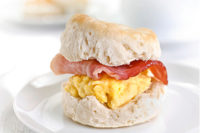Modern processors have a variety of freezing systems to choose from, with each having their own benefits and drawbacks. One constant among them is the power necessary to operate them. There are some things a company can do to help limit the price impact.
“We have many different initiatives in place for reduction and conservation,” says Steve Valesko, vice president of engineering at Kings Mountain, N.C.-based Butterball LLC. All of Butterball’s plants are in states that have not deregulated electrical markets, limiting the company's abilities to reduce costs by shopping around for new power suppliers. The only option is conservation.
Another limit is available capacity. Valesko says that issues such as the size of the system, how much ammonia for coolant is available and how much room is accessible in the facility, all have to be taken into account.
Matter of choice
There is more than one choice for a freezing system. The most basic is the blast chiller. This system is essentially an insulated room using large evaporators and fans to blast cold air (down to minus-30 degrees) at products. The only difference between a blast chiller and a regular freezer is that the fans are aimed to remove the heat energy of a product at a high rate, according to Lee Johnson, Ph.D., director of technical services for Butterball.“It’s the most popular because it’s lower cost,” Johnson says. Coolant is still required to chill the air to the needed temperature, but it can be relatively inexpensive ammonia such as that which Butterball uses. Smaller operators may use carbon dioxide, which can be a better coolant when condensed, but is also more expensive.
Carbon dioxide and nitrogen can be cooled to a lower temperature than ammonia. That makes both better coolants. Because of the higher temperature differential between cooled carbon dioxide and nitrogen, it can chill and freeze products quicker.
For example, nitrogen can be taken down to minus-130 degrees, compared to the aforementioned minus-30 degrees for ammonia. Both are very cold, but the lower temperature of the nitrogen will allow for a faster heat transfer. As the temperature of the environment and that of the product near equilibrium, the process slows. For example, a product at 40 degrees will drop quickly to, say, minus-20 degrees regardless of the coolant. However, an ammonia system will have to work harder to get the product to reach minus-30 degrees than a nitrogen or carbon dioxide system.
Many products taken to a blast chiller are placed on a pallet for freezing. In the chiller, air flow is most important, with many companies using a spacer to ensure the proper amount.
“By adding spacers, you can allow some of that air velocity and movement to increase heat transfer,” Johnson says. “Basically you’re trying to move heat energy.”
The separation also helps counteract the insulating effect of any packaging on the product. Cryogenic systems use nitrogen and carbon dioxide to very quickly and efficiently cool products. The methods can be a carbon dioxide snow or a liquid nitrogen mist.
There are some drawbacks, of course. First, since the coolants are used as consumables, it can be very expensive. Valesko says that the costs for the materials, like other commodities, have gone up recently. How the coolants are distributed also can be a major factor.
“It’s so cold [that,] if you don’t distribute it well enough, you can get pockets that aren’t frozen, [or] other areas that are frozen too much,” says Johnson.
The advantages of cryogenics help balance out that cost. Unlike blast chillers, which can take hours to finish the process, the cryogenic system can freeze products within a relatively short and compact part of the regular production line.
“You might use nitrogen or CO2 (carbon dioxide) and you do a conveyor system through the tunnel and everything comes out frozen,” Johnson says. “The advantage is twofold. You get consistent, fast chilling. It’s easy, inline, very efficient. The disadvantage is cost, because the materials are expensive. But if you don’t have a lot of floor space or freezer capacity, it is useful.”
This freezing system works best on smaller items such as chicken nuggets that can be cooled from outside in very quickly. It also freezes products quickly and evenly enough to prevent clumping.
For larger items such as turkey breasts or frozen whole birds, the blast chiller is the better choice. The larger mass of the product requires a longer cooling time, and using cryogenic systems offers no advantage.
Some tumblers can be used to freeze products. Plate contact systems will pull the heat energy out of a product on direct contact. Blast chillers, where the chilled air is making direct contact, work in a similar way, transferring the energy from the product to the cooler material. But processors need to be careful because direct contact can remove water from a product and reduce yield.
Another method, though rarely used in the meat-processing industry, is liquid immersion. Brines freeze at a lower temperature than pure water, and, depending on the solution, can be chilled below the freezing point of products immersed in it. The chillers many poultry processors use in processing work on a similar principle.
No matter what method is being used, there are two thermodynamic principles at work – conduction and convection.
Conduction is where is energy is moved from molecule to molecule. Convection is where it moves through air or fluid. As that’s happening, the heat is moving from the inner part of a product to the outside surface.
“Those same components apply for any system,” Johnson says. “Energy has to move out of the product. It’s dependent on the difference of temperature.”
Speed counts
Freezing products quickly is important for reasons other than keeping a processing line moving efficiently. Quick freezing is necessary to maintain the quality of any product being frozen.When a product freezes, the water inside crystallizes. And as everyone remembers from high school science, water expands as it freezes. Johnson says that by freezing quickly, the water crystals are kept small. If the crystals become larger and build on themselves, they can rupture the cell membranes of the meat. That means a loss of water and overall quality when the product is thawed.
And while freezing will help maintain freshness, it is not an overall solution to food safety in one shot. Johnson says that bacteria, if present, can keep growing until the product is frozen solid, essentially putting it in suspended animation.
“Freezing doesn’t kill that much,” he continues. “It does kill bacteria, but not a significant amount. You have to assume it’s at the place it was frozen.”
Freezing stops most chemical activity as well, but not all. Fatty acid oxidation is still a possibility, Johnson says, which can result in something best described as a “warmed-over” flavor. How much happens depends on the amount of unsaturated fat in a product, with it happening in pork a bit more often. While the reaction is slowed a great deal, oxygen can still get through any packaging and oxidize the fat.
With all of these variables taken into account, freezing does significantly add to the shelf life, especially if frozen at the plant and kept that way. A frozen item can be kept 275 days to a year, depending on the product.
Special precautions do need to be taken by workers as well. Protective clothing, especially gloves, are required to safely use this equipment. Dry ice (frozen carbon dioxide) and liquid nitrogen can cause severe injuries if they come into contact with the skin, creating a freezer burn. As the carbon dioxide and nitrogen change into a gaseous state after use, the gasses will tend to be heavier than air. Good ventilation is a must for safety, especially with carbon dioxide.
Even a blast chiller gets to temperatures rarely seen outside the Arctic Circle. Proper attire is needed for anyone spending any time in the blast chiller as part of their duties.





